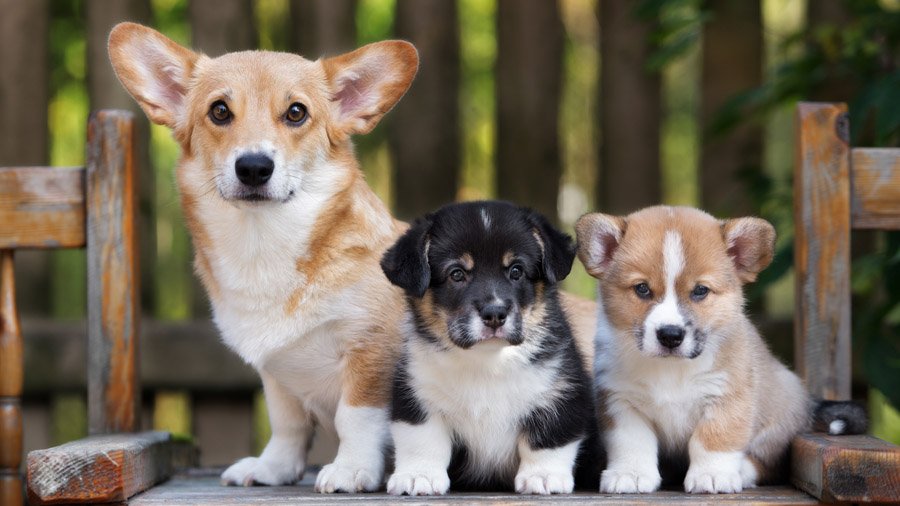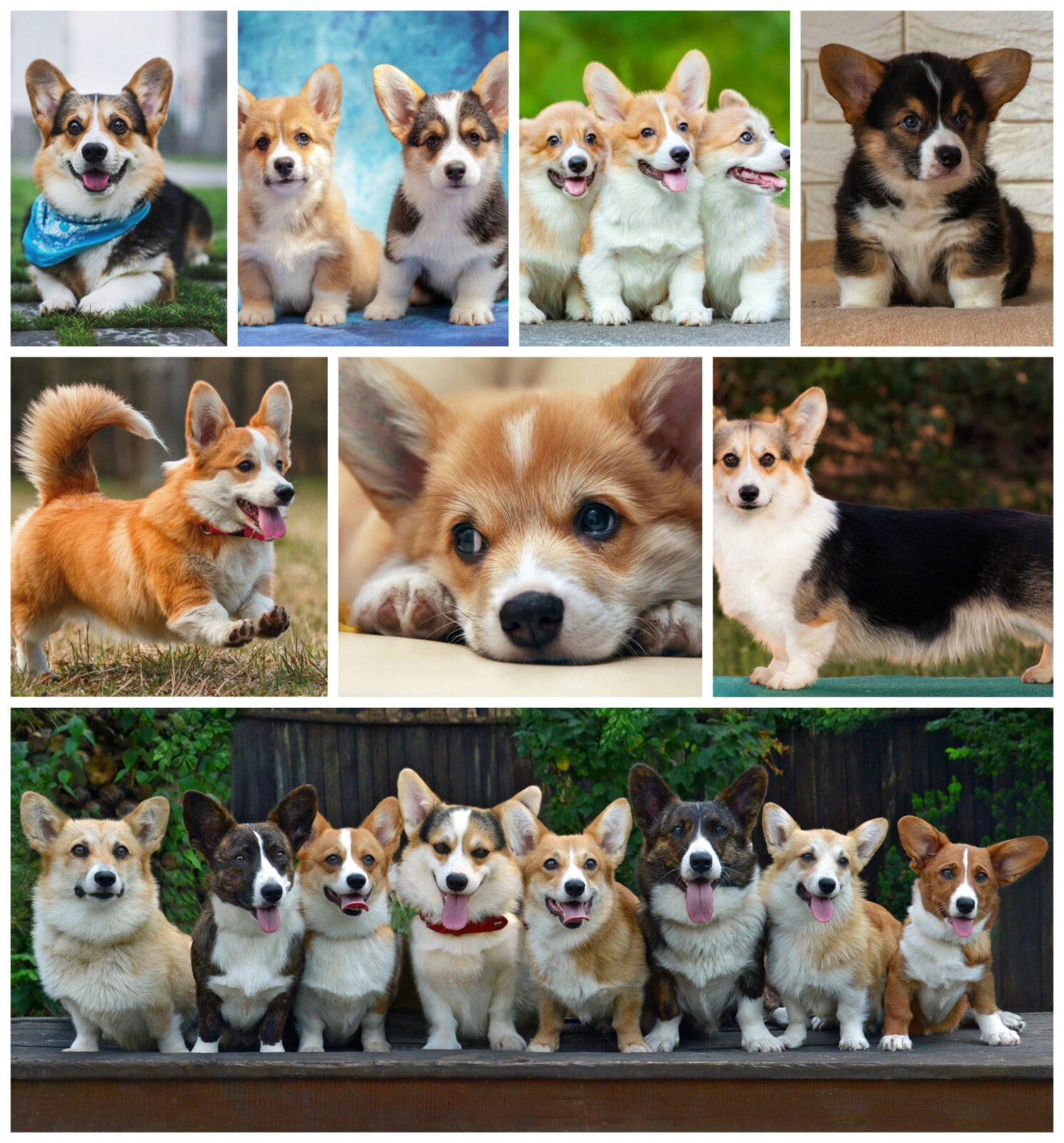
Brief description of the breed
The Pembroke Welsh Corgi appeared around the twelfth century. This makes it younger in comparison with its immediate relative. - welsh corgi cardigan. Some researchers of the history of dogs suggest that the name of the breed comes from the Welsh word "korg" - dwarf. The thick and soft coat can be red, sable, fawn or black and tan with the characteristic white markings of this breed. Ideally, the growth of a Welsh Corgi should be about 25-30 centimeters at the withers, and the weight can vary from 12 to 15 kilograms.
The coat of the Welsh Corgi is of medium length and has a downy undercoat. Coat length and appearance may vary slightly. For example, some representatives of the breed have a fluffy edge on the ears, while others have an original ruff on the neck. Some Welsh Corgi have wavy hair, while others - straight. But all this does not affect the character and general characteristics. dogs... Distinctive feature of the Pembrokes - a saddle mark on the back, often referred to as the "fairy saddle."
👉WHAT YOU SHOULD KNOW ABOUT WELSH KORGI IF YOU ALREADY LOVE THEM?👈
basic information
| Breed name: | Welsh corgi |
| Country of origin: | United Kingdom |
| The time of the birth of the breed: | 3000 years ago |
| Type of: | herders and cattle |
| The weight: | 12 - 15 kg |
| Height (height at the withers): | 25 - 30 cm |
| Life Expectancy: | 12 - 15 years old |
|
ICF classification:
|
Group 1, Section 1, Number 38-39 |
| Puppies price: | 900 – 2100 $ |
| Most popular nicknames: | list of nicknames for welsh corgi |
Assessment of breed characteristics
| Adaptability
(a definition meaning how easily a dog can adapt to changes in life) |
🐶🐶🐶🐶🐶 |
| Shedding level
(Level and frequency of hair loss in the animal) |
🐶🐶🐶🐶🐶 |
| Tenderness level
(The level and amount of tenderness and affection that the dog gives in return for attention to itself) |
🐶🐶🐶🐶🐶 |
| Exercise needs
(Dog's daytime activity level) |
🐶🐶🐶🐶 |
| Social need
(The required number of contacts of the dog with other animals, as well as people) |
🐶🐶🐶 |
| Apartment content
(A factor that determines the level of noise and other inconveniences that a dog can deliver to owners in relation to the size of the apartment to the size of the dog) |
🐶🐶🐶🐶🐶 |
| Grooming
(The number of bathing, brushing, and the number of professional grooming sessions required for the dog) |
🐶🐶🐶 |
| Friendliness in an unfamiliar environment
(Features of the behavior of a dog in a society with strangers or in an unfamiliar environment) |
🐶🐶🐶 |
| Tendency to bark
(Tendency to bark and its frequency and volume) |
🐶🐶🐶 |
| Health issues
(Potential health status of the dog) |
🐶🐶 |
| Territoriality
(The dog's tendency to protect his home, yard, or even his owner's car) |
🐶🐶🐶 |
| Friendliness to cats
(The tendency towards tolerance for cats and decreased manifestation of hunting instincts) |
🐶🐶🐶🐶🐶 |
| Intelligence
(The ability of the dog to think and solve emerging difficulties (not to be confused with learning!) |
🐶🐶🐶🐶🐶 |
| Education and training
(The level of difficulty in training the dog to perform certain actions) |
🐶🐶🐶🐶🐶 |
| Friendliness to children
(A factor that determines how friendly a dog is to children, whether he likes to play with them and tolerate some childish pranks) |
🐶🐶🐶🐶🐶 |
| Game activity
(The concept is determined by its very name, and, as a rule, is found in almost all dogs) |
🐶🐶🐶🐶 |
| Observation
(The ability of a dog to detect the presence of a stranger on its territory) |
🐶🐶🐶🐶🐶 |
| Friendliness to other dogs
(The tendency of the dog to find common language with his other relatives) |
🐶🐶🐶 |
Photo of welsh corgi:

The origin story of the welsh corgi
The Welsh Corgi has a fairly rich history. His ancestors were brought to England from the mainland in 1107 by Flemish weavers who eventually settled in southwestern Wales. The breed has common roots with the Keeshond and chow-chow, Finnish and pomeranianas well as the Norwegian Elkhound, which were originally bred to help shepherds graze sheep and cattle. Because of their physique, corgi were highly prized among shepherds. They also helped drive large flocks of geese to market. Over time, they became so fond of the shepherds that they took their rightful place as a pet and a real family member.
The similarity between the Pembroke and the Cardigan Welsh Corgi is no coincidence. Both breeds were crossed in the early nineteenth century when Cardigan puppies were sold to farmers in the Pembrokeshire and Carmarthenshire region. Mass crossing of these breeds began in the early twentieth century. Modern breeders do not allow incest of the two breeds of dogs, keeping a separate pedigree of the Pembroke and the Cardigan.
The English Welsh Corgi Club was founded in 1925. The Pembroke Welsh Corgi and Cardigan Welsh Corgi were recognized as an independent breed by the English Kennel Club in 1934. Queen Elizabeth II treated this breed with special trepidation, despite the fact that shepherd dogs brought a lot of trouble to Buckingham Palace. It was the royal court's special relationship with the Pembroke that allowed the breed's popularity to soar especially high in comparison to the Cardigan.
The American Kennel Club recognized the Welsh Corgi in 1934 and assigned him to the herding dog group. Two years later, the first club of lovers of this breed appeared in the USA. Today the welsh corgi is dog, which shows special abilities in agility, executing commands, she has become a real friend for thousands of families.
The nature of the welsh corgi
Although the Welsh Corgi is a relatively small dog, it has a very wide and kind soul. Their character and behavior developed mainly on the basis of the fact that for a long time the ancestors of this breed were engaged in grazing livestock, led an active lifestyle, were constantly on the move.
Today, corgi are still very popular on various farms, but they are especially popular among active families. This is understandable, for passive people with limited free time, corgi, of course, will not work. These dogs get along well with other pets. They are unsurpassed in coping with the tasks of guard dogs.
Welsh Corgis are dogs with their own "I", they have their own opinion and want to be reckoned with. But their main desire is to please people, especially those close to them. Observing the behavior of the corgi, you can see how amazing doggies change their behavior: from buffoonery to insanely serious.
Despite the high level of activity of the Welsh Corgi, it is not at all necessary for them to do a huge amount of physical exercise. A very small amount of active walks, games or other exercises will be enough to maintain health and good mood.
Representatives of this breed perfectly adapt to various living conditions. They feel great on farms, in private houses with their own backyards, in an apartment or even in a hostel. The main thing - so that your pet does not interfere with others. But you need to understand that regardless of where you live, the dog needs to be walked in the fresh air every day, play with it, and go to the park at least once a week.
We mentioned that corgi can do great without vigorous exercise, but that can't be said for vigorous mental stimulation. Corgi owners should provide their pet with enough logical, interactive games. Otherwise, the character of the pet can deteriorate sharply, from which both the surrounding people and the furniture, as well as household items, will suffer.
Maintenance and care
Welsh Corgi are very easy to care for. Their coat is not very long and requires only weekly brushing. This is enough to remove dead hairs. The phases of active molting in the Welsh Corgi occur twice a year. During this period, of course, you need to brush your pet much more often. Pembrokes are very clean dogs, so most owners bathe them about once every two to three months.
The corgi's ears should be checked regularly for signs of contamination, irritation, or infection. They must be cleaned with a special solution as prescribed by a veterinarian. In no case should you use a cotton swab to clean the ear canal!
The oral cavity also includes weekly care. Mainly teeth cleaning is required. The procedure will help to exclude dental diseases, including the formation of tartar, as well as the occurrence of the characteristic bad breath. If the pet does not grind off its nails in a natural way, then they must be trimmed on their own. This is usually done once a month.
Welsh Corgi training and education
Welsh Corgi have a strong-willed character. They are used to getting what they want. Therefore, in the learning process, you will need a lot of patience and endurance. The main assistant in training will be rewards in the form of treats and, of course, in the form of praise. Please note that when training a dog, you need to completely forget about rudeness and aggression, which will have a negative effect. The animal should enjoy the activity, so it is better to conduct short, but more frequent activities that will not bother the pet.
The training of dogs of this breed assumes a certain consistency. It is necessary to move from simple to complex. After mastering the basic commands and tasks, feel free to move on to teaching tracking and agility. It is necessary to give the pet the opportunity to develop and direct all its energy in a useful direction.
Welsh corgi - excellent watchmen. They will sound the alarm in a timely manner at the sight of intruders, but this behavior must be controlled through early training. That is why the stage of socialization occupies an important place in the life of dogs of this breed. Welsh Corgi is distrustful of strangers, your task is to teach your pet to distinguish a stranger from yours. Otherwise, the dog will often bark, which will not really please your neighbors, and what can we say in the case when you live in a hostel ...
While most dogs show a special affection for children, corgi can show dominance, especially when it comes to a group of children. The dog will perceive them as an object for grazing, all this is formed at the genetic level. It is with this that the requirement of experienced breeders about the inexpediency of playing corgi with children without adult supervision is connected.
Health and illness of the welsh corgi
Some interesting facts
- The Welsh Corgi is considered one of the most ancient dogs.
- Despite their small stature, these dogs do an excellent job with various active tasks.
- Corgi lends itself well to training, provided that it is started from an early age.
- For dogs of this breed, an early socialization process is required.
- Welsh Corgi will be able to live in any house, regardless of size.
- Taking care of a pet of this breed is very simple.
- It is better not to buy corgi for families with many children.
Nurseries and breeders
We borrowed material from the wonderful site of our partners DOGCATFAN.COM about cats and dogs, the author dogcatfan
About corgi first-hand: photos and stories of the owners
View this post on Instagram
View this post on Instagram
View this post on Instagram
